Report: Screening and Treatment of Substance and Drug Abuse Clients
VerifiedAdded on 2023/01/18
|7
|1342
|56
Report
AI Summary
This report delves into the critical issue of substance and drug abuse, examining effective screening methods and therapeutic interventions. It highlights the importance of early identification of drug misuse, particularly among youths, and emphasizes the need for tailored approaches for different demographics, including adolescents and tobacco users. The report outlines structured questioning techniques for screening and discusses the benefits and challenges of brief interventions. It underscores the significance of preventive measures and parental education in combating the problem, advocating for a proactive approach to address substance abuse before it escalates. The report also provides a brief overview of the existing research and provides insights into the evolving landscape of addiction treatment and public health strategies.
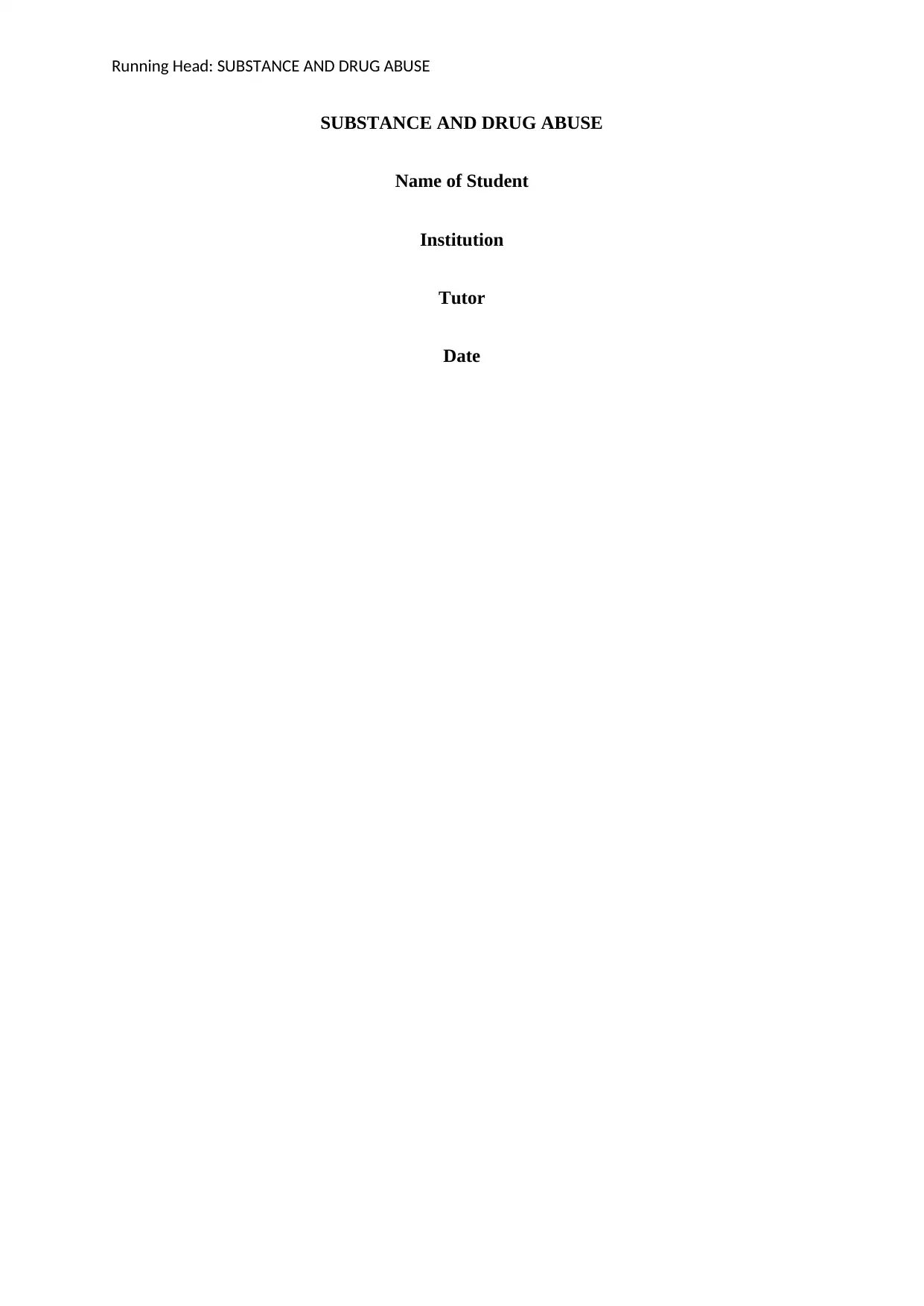
Running Head: SUBSTANCE AND DRUG ABUSE
SUBSTANCE AND DRUG ABUSE
Name of Student
Institution
Tutor
Date
SUBSTANCE AND DRUG ABUSE
Name of Student
Institution
Tutor
Date
Paraphrase This Document
Need a fresh take? Get an instant paraphrase of this document with our AI Paraphraser
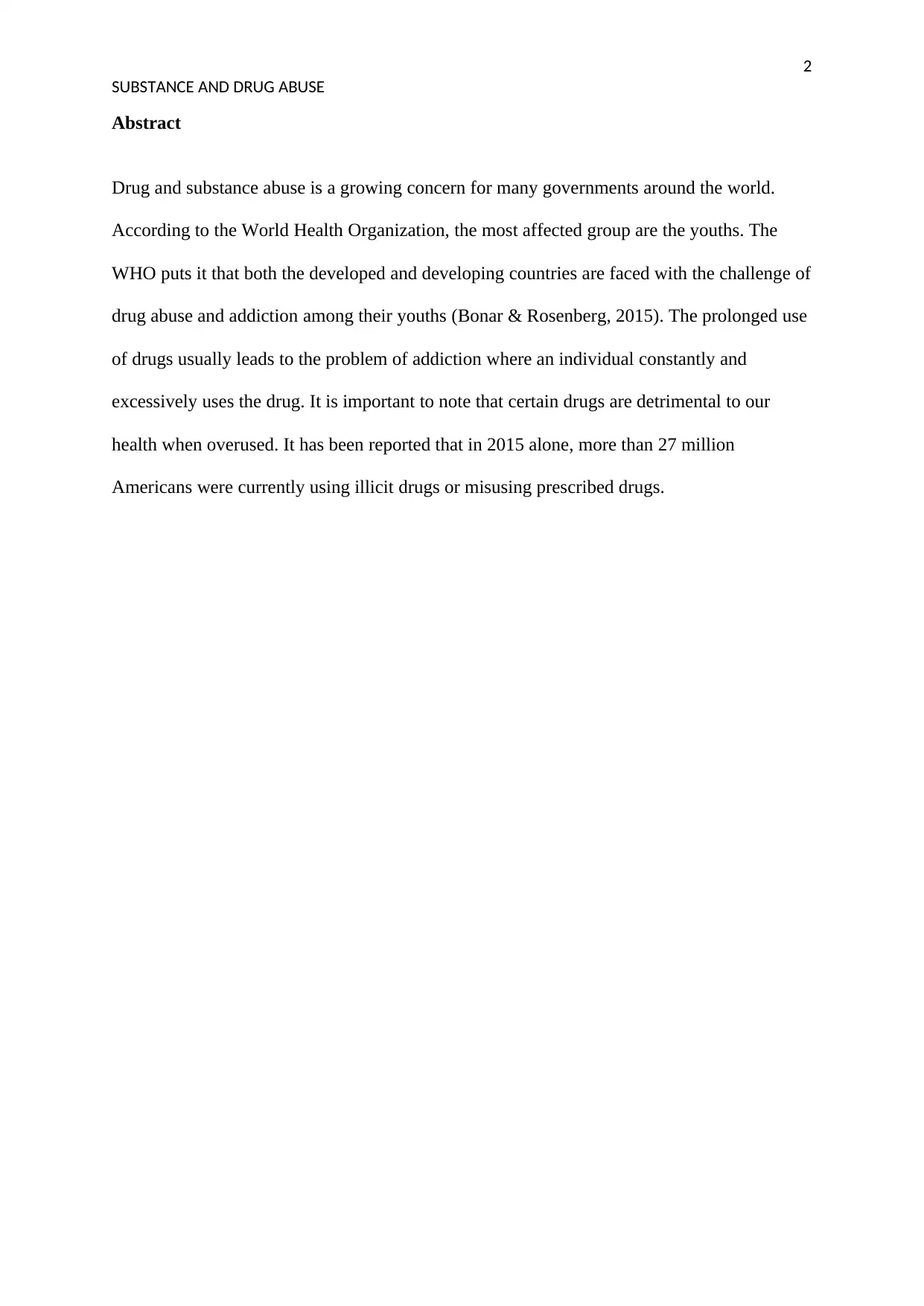
2
SUBSTANCE AND DRUG ABUSE
Abstract
Drug and substance abuse is a growing concern for many governments around the world.
According to the World Health Organization, the most affected group are the youths. The
WHO puts it that both the developed and developing countries are faced with the challenge of
drug abuse and addiction among their youths (Bonar & Rosenberg, 2015). The prolonged use
of drugs usually leads to the problem of addiction where an individual constantly and
excessively uses the drug. It is important to note that certain drugs are detrimental to our
health when overused. It has been reported that in 2015 alone, more than 27 million
Americans were currently using illicit drugs or misusing prescribed drugs.
SUBSTANCE AND DRUG ABUSE
Abstract
Drug and substance abuse is a growing concern for many governments around the world.
According to the World Health Organization, the most affected group are the youths. The
WHO puts it that both the developed and developing countries are faced with the challenge of
drug abuse and addiction among their youths (Bonar & Rosenberg, 2015). The prolonged use
of drugs usually leads to the problem of addiction where an individual constantly and
excessively uses the drug. It is important to note that certain drugs are detrimental to our
health when overused. It has been reported that in 2015 alone, more than 27 million
Americans were currently using illicit drugs or misusing prescribed drugs.
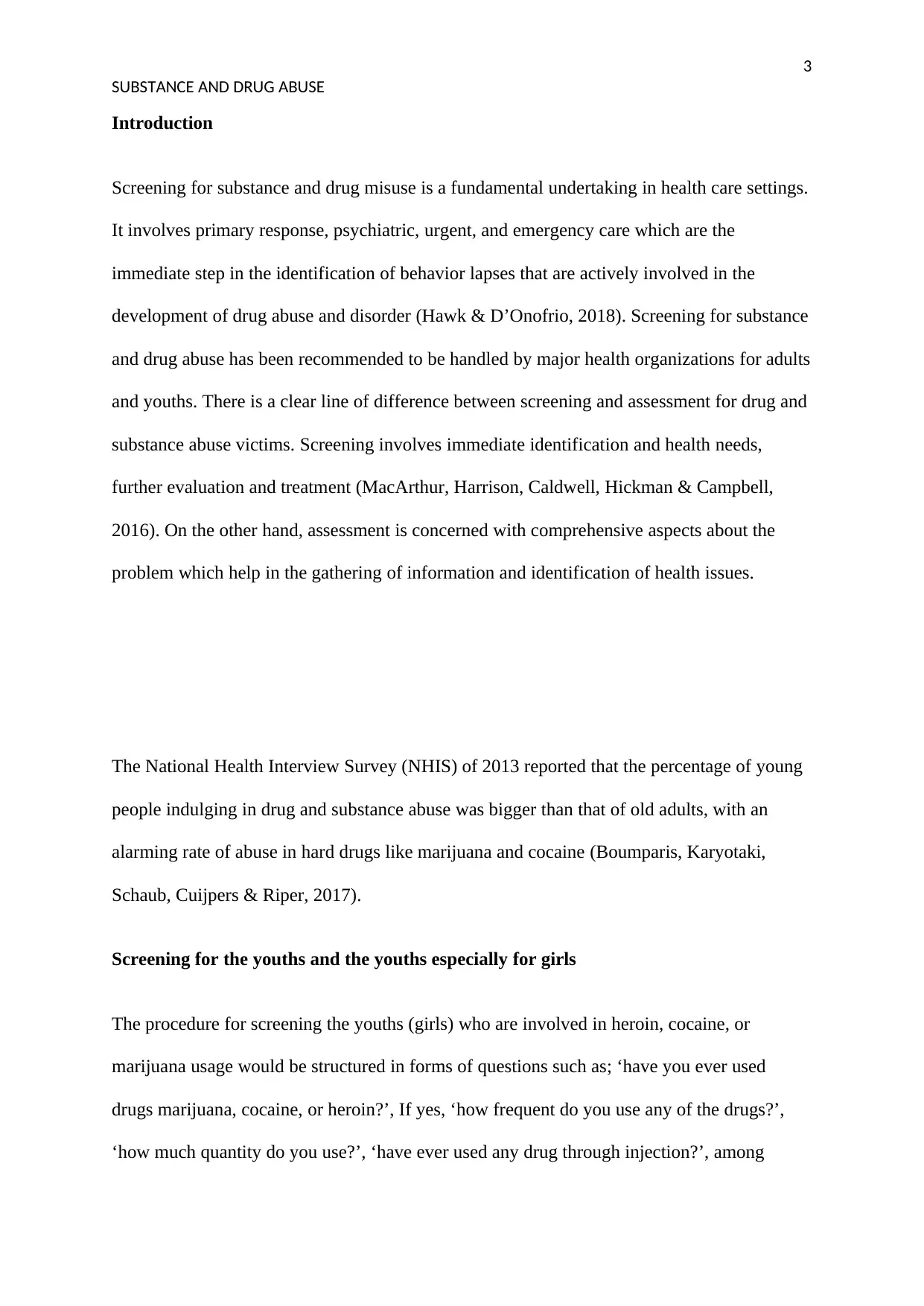
3
SUBSTANCE AND DRUG ABUSE
Introduction
Screening for substance and drug misuse is a fundamental undertaking in health care settings.
It involves primary response, psychiatric, urgent, and emergency care which are the
immediate step in the identification of behavior lapses that are actively involved in the
development of drug abuse and disorder (Hawk & D’Onofrio, 2018). Screening for substance
and drug abuse has been recommended to be handled by major health organizations for adults
and youths. There is a clear line of difference between screening and assessment for drug and
substance abuse victims. Screening involves immediate identification and health needs,
further evaluation and treatment (MacArthur, Harrison, Caldwell, Hickman & Campbell,
2016). On the other hand, assessment is concerned with comprehensive aspects about the
problem which help in the gathering of information and identification of health issues.
The National Health Interview Survey (NHIS) of 2013 reported that the percentage of young
people indulging in drug and substance abuse was bigger than that of old adults, with an
alarming rate of abuse in hard drugs like marijuana and cocaine (Boumparis, Karyotaki,
Schaub, Cuijpers & Riper, 2017).
Screening for the youths and the youths especially for girls
The procedure for screening the youths (girls) who are involved in heroin, cocaine, or
marijuana usage would be structured in forms of questions such as; ‘have you ever used
drugs marijuana, cocaine, or heroin?’, If yes, ‘how frequent do you use any of the drugs?’,
‘how much quantity do you use?’, ‘have ever used any drug through injection?’, among
SUBSTANCE AND DRUG ABUSE
Introduction
Screening for substance and drug misuse is a fundamental undertaking in health care settings.
It involves primary response, psychiatric, urgent, and emergency care which are the
immediate step in the identification of behavior lapses that are actively involved in the
development of drug abuse and disorder (Hawk & D’Onofrio, 2018). Screening for substance
and drug abuse has been recommended to be handled by major health organizations for adults
and youths. There is a clear line of difference between screening and assessment for drug and
substance abuse victims. Screening involves immediate identification and health needs,
further evaluation and treatment (MacArthur, Harrison, Caldwell, Hickman & Campbell,
2016). On the other hand, assessment is concerned with comprehensive aspects about the
problem which help in the gathering of information and identification of health issues.
The National Health Interview Survey (NHIS) of 2013 reported that the percentage of young
people indulging in drug and substance abuse was bigger than that of old adults, with an
alarming rate of abuse in hard drugs like marijuana and cocaine (Boumparis, Karyotaki,
Schaub, Cuijpers & Riper, 2017).
Screening for the youths and the youths especially for girls
The procedure for screening the youths (girls) who are involved in heroin, cocaine, or
marijuana usage would be structured in forms of questions such as; ‘have you ever used
drugs marijuana, cocaine, or heroin?’, If yes, ‘how frequent do you use any of the drugs?’,
‘how much quantity do you use?’, ‘have ever used any drug through injection?’, among
⊘ This is a preview!⊘
Do you want full access?
Subscribe today to unlock all pages.

Trusted by 1+ million students worldwide
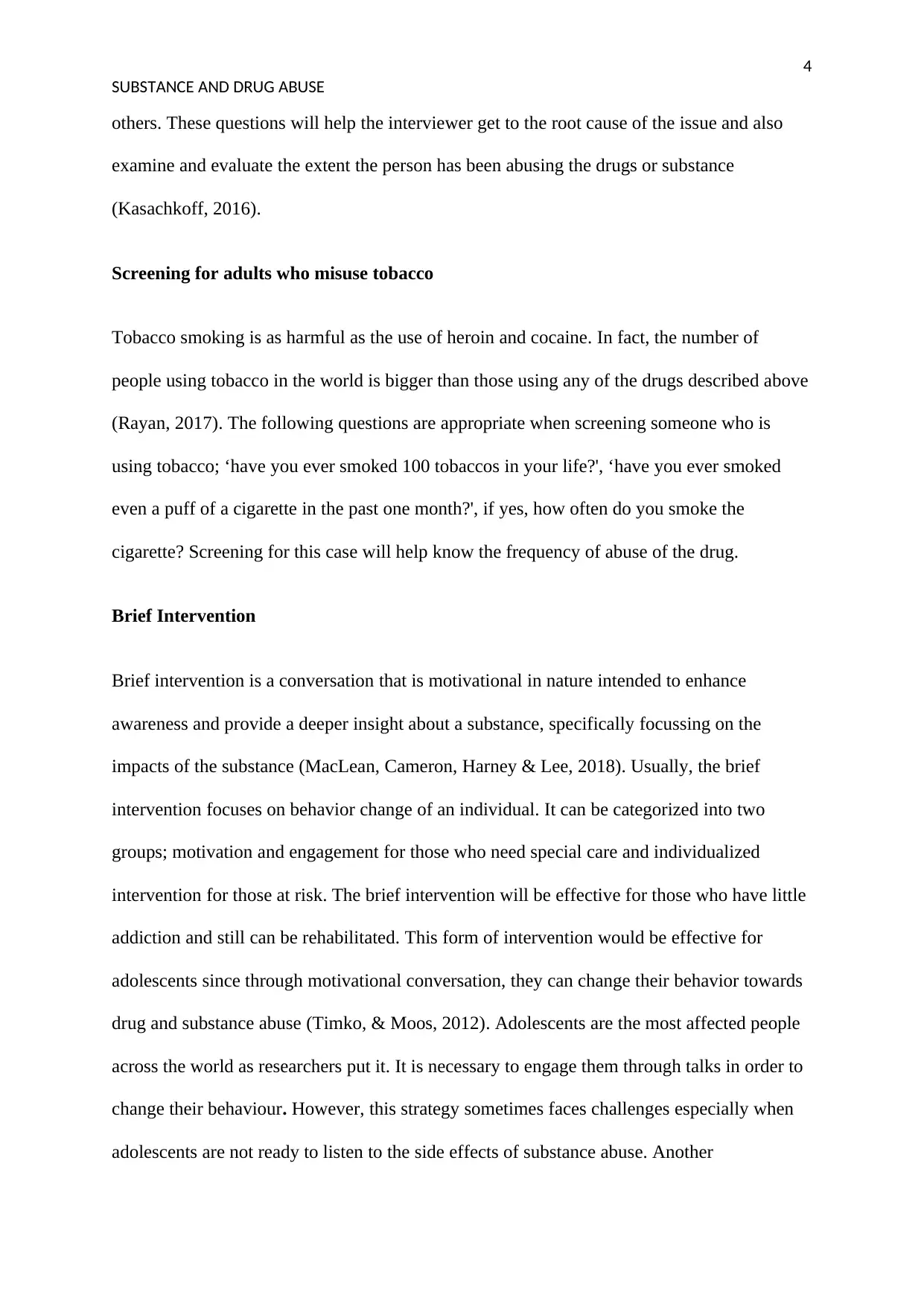
4
SUBSTANCE AND DRUG ABUSE
others. These questions will help the interviewer get to the root cause of the issue and also
examine and evaluate the extent the person has been abusing the drugs or substance
(Kasachkoff, 2016).
Screening for adults who misuse tobacco
Tobacco smoking is as harmful as the use of heroin and cocaine. In fact, the number of
people using tobacco in the world is bigger than those using any of the drugs described above
(Rayan, 2017). The following questions are appropriate when screening someone who is
using tobacco; ‘have you ever smoked 100 tobaccos in your life?', ‘have you ever smoked
even a puff of a cigarette in the past one month?', if yes, how often do you smoke the
cigarette? Screening for this case will help know the frequency of abuse of the drug.
Brief Intervention
Brief intervention is a conversation that is motivational in nature intended to enhance
awareness and provide a deeper insight about a substance, specifically focussing on the
impacts of the substance (MacLean, Cameron, Harney & Lee, 2018). Usually, the brief
intervention focuses on behavior change of an individual. It can be categorized into two
groups; motivation and engagement for those who need special care and individualized
intervention for those at risk. The brief intervention will be effective for those who have little
addiction and still can be rehabilitated. This form of intervention would be effective for
adolescents since through motivational conversation, they can change their behavior towards
drug and substance abuse (Timko, & Moos, 2012). Adolescents are the most affected people
across the world as researchers put it. It is necessary to engage them through talks in order to
change their behaviour. However, this strategy sometimes faces challenges especially when
adolescents are not ready to listen to the side effects of substance abuse. Another
SUBSTANCE AND DRUG ABUSE
others. These questions will help the interviewer get to the root cause of the issue and also
examine and evaluate the extent the person has been abusing the drugs or substance
(Kasachkoff, 2016).
Screening for adults who misuse tobacco
Tobacco smoking is as harmful as the use of heroin and cocaine. In fact, the number of
people using tobacco in the world is bigger than those using any of the drugs described above
(Rayan, 2017). The following questions are appropriate when screening someone who is
using tobacco; ‘have you ever smoked 100 tobaccos in your life?', ‘have you ever smoked
even a puff of a cigarette in the past one month?', if yes, how often do you smoke the
cigarette? Screening for this case will help know the frequency of abuse of the drug.
Brief Intervention
Brief intervention is a conversation that is motivational in nature intended to enhance
awareness and provide a deeper insight about a substance, specifically focussing on the
impacts of the substance (MacLean, Cameron, Harney & Lee, 2018). Usually, the brief
intervention focuses on behavior change of an individual. It can be categorized into two
groups; motivation and engagement for those who need special care and individualized
intervention for those at risk. The brief intervention will be effective for those who have little
addiction and still can be rehabilitated. This form of intervention would be effective for
adolescents since through motivational conversation, they can change their behavior towards
drug and substance abuse (Timko, & Moos, 2012). Adolescents are the most affected people
across the world as researchers put it. It is necessary to engage them through talks in order to
change their behaviour. However, this strategy sometimes faces challenges especially when
adolescents are not ready to listen to the side effects of substance abuse. Another
Paraphrase This Document
Need a fresh take? Get an instant paraphrase of this document with our AI Paraphraser
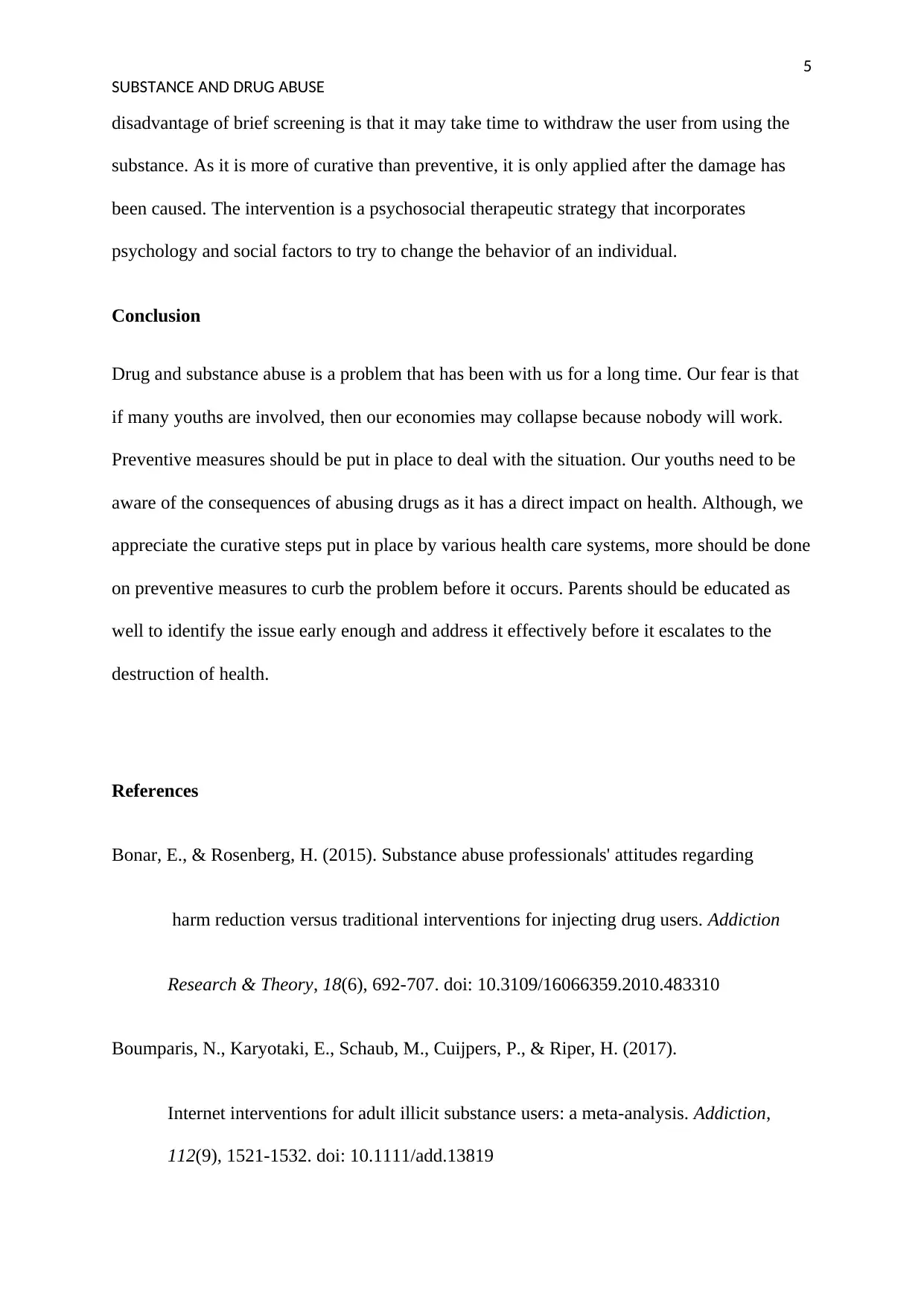
5
SUBSTANCE AND DRUG ABUSE
disadvantage of brief screening is that it may take time to withdraw the user from using the
substance. As it is more of curative than preventive, it is only applied after the damage has
been caused. The intervention is a psychosocial therapeutic strategy that incorporates
psychology and social factors to try to change the behavior of an individual.
Conclusion
Drug and substance abuse is a problem that has been with us for a long time. Our fear is that
if many youths are involved, then our economies may collapse because nobody will work.
Preventive measures should be put in place to deal with the situation. Our youths need to be
aware of the consequences of abusing drugs as it has a direct impact on health. Although, we
appreciate the curative steps put in place by various health care systems, more should be done
on preventive measures to curb the problem before it occurs. Parents should be educated as
well to identify the issue early enough and address it effectively before it escalates to the
destruction of health.
References
Bonar, E., & Rosenberg, H. (2015). Substance abuse professionals' attitudes regarding
harm reduction versus traditional interventions for injecting drug users. Addiction
Research & Theory, 18(6), 692-707. doi: 10.3109/16066359.2010.483310
Boumparis, N., Karyotaki, E., Schaub, M., Cuijpers, P., & Riper, H. (2017).
Internet interventions for adult illicit substance users: a meta-analysis. Addiction,
112(9), 1521-1532. doi: 10.1111/add.13819
SUBSTANCE AND DRUG ABUSE
disadvantage of brief screening is that it may take time to withdraw the user from using the
substance. As it is more of curative than preventive, it is only applied after the damage has
been caused. The intervention is a psychosocial therapeutic strategy that incorporates
psychology and social factors to try to change the behavior of an individual.
Conclusion
Drug and substance abuse is a problem that has been with us for a long time. Our fear is that
if many youths are involved, then our economies may collapse because nobody will work.
Preventive measures should be put in place to deal with the situation. Our youths need to be
aware of the consequences of abusing drugs as it has a direct impact on health. Although, we
appreciate the curative steps put in place by various health care systems, more should be done
on preventive measures to curb the problem before it occurs. Parents should be educated as
well to identify the issue early enough and address it effectively before it escalates to the
destruction of health.
References
Bonar, E., & Rosenberg, H. (2015). Substance abuse professionals' attitudes regarding
harm reduction versus traditional interventions for injecting drug users. Addiction
Research & Theory, 18(6), 692-707. doi: 10.3109/16066359.2010.483310
Boumparis, N., Karyotaki, E., Schaub, M., Cuijpers, P., & Riper, H. (2017).
Internet interventions for adult illicit substance users: a meta-analysis. Addiction,
112(9), 1521-1532. doi: 10.1111/add.13819
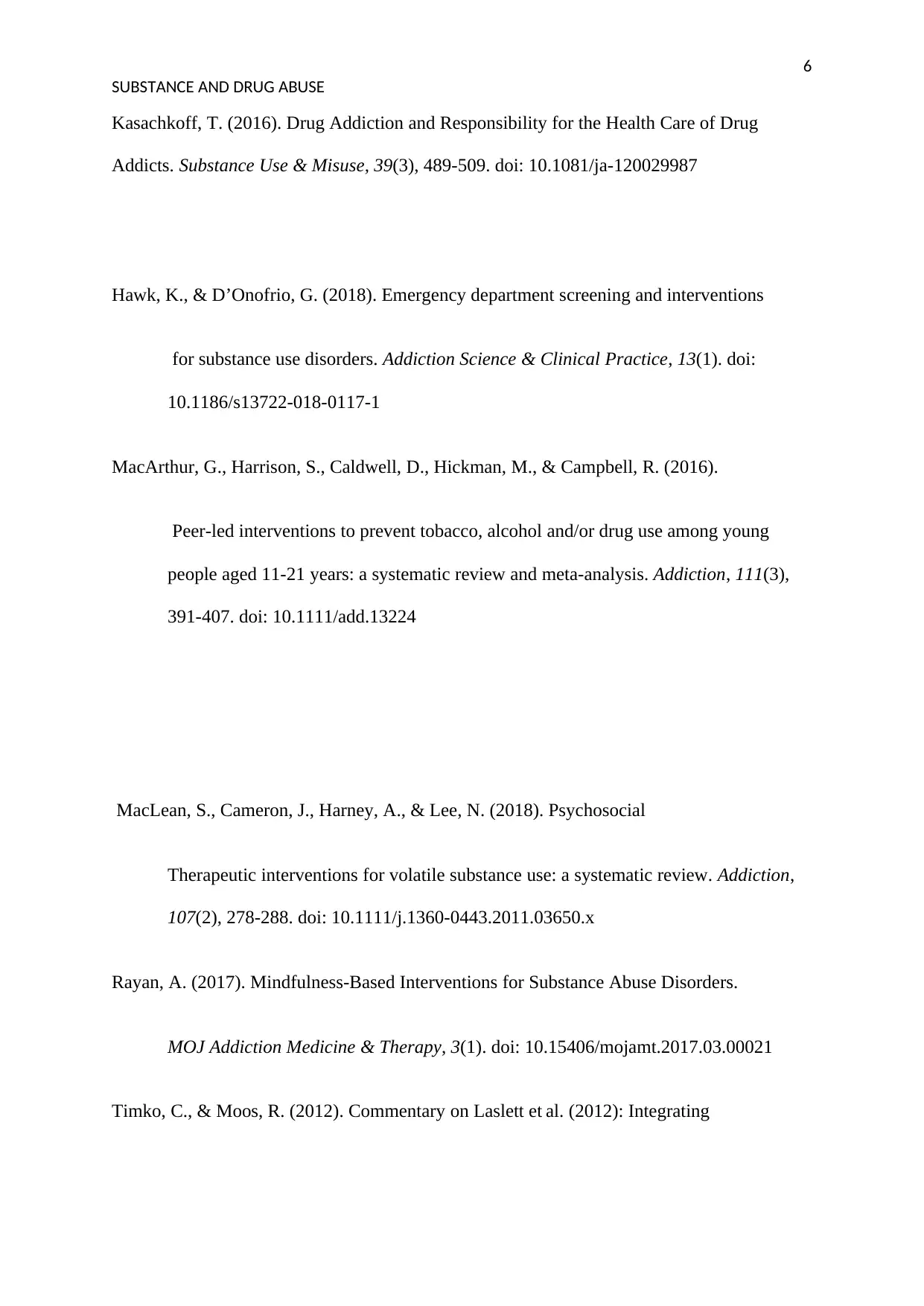
6
SUBSTANCE AND DRUG ABUSE
Kasachkoff, T. (2016). Drug Addiction and Responsibility for the Health Care of Drug
Addicts. Substance Use & Misuse, 39(3), 489-509. doi: 10.1081/ja-120029987
Hawk, K., & D’Onofrio, G. (2018). Emergency department screening and interventions
for substance use disorders. Addiction Science & Clinical Practice, 13(1). doi:
10.1186/s13722-018-0117-1
MacArthur, G., Harrison, S., Caldwell, D., Hickman, M., & Campbell, R. (2016).
Peer-led interventions to prevent tobacco, alcohol and/or drug use among young
people aged 11-21 years: a systematic review and meta-analysis. Addiction, 111(3),
391-407. doi: 10.1111/add.13224
MacLean, S., Cameron, J., Harney, A., & Lee, N. (2018). Psychosocial
Therapeutic interventions for volatile substance use: a systematic review. Addiction,
107(2), 278-288. doi: 10.1111/j.1360-0443.2011.03650.x
Rayan, A. (2017). Mindfulness-Based Interventions for Substance Abuse Disorders.
MOJ Addiction Medicine & Therapy, 3(1). doi: 10.15406/mojamt.2017.03.00021
Timko, C., & Moos, R. (2012). Commentary on Laslett et al. (2012): Integrating
SUBSTANCE AND DRUG ABUSE
Kasachkoff, T. (2016). Drug Addiction and Responsibility for the Health Care of Drug
Addicts. Substance Use & Misuse, 39(3), 489-509. doi: 10.1081/ja-120029987
Hawk, K., & D’Onofrio, G. (2018). Emergency department screening and interventions
for substance use disorders. Addiction Science & Clinical Practice, 13(1). doi:
10.1186/s13722-018-0117-1
MacArthur, G., Harrison, S., Caldwell, D., Hickman, M., & Campbell, R. (2016).
Peer-led interventions to prevent tobacco, alcohol and/or drug use among young
people aged 11-21 years: a systematic review and meta-analysis. Addiction, 111(3),
391-407. doi: 10.1111/add.13224
MacLean, S., Cameron, J., Harney, A., & Lee, N. (2018). Psychosocial
Therapeutic interventions for volatile substance use: a systematic review. Addiction,
107(2), 278-288. doi: 10.1111/j.1360-0443.2011.03650.x
Rayan, A. (2017). Mindfulness-Based Interventions for Substance Abuse Disorders.
MOJ Addiction Medicine & Therapy, 3(1). doi: 10.15406/mojamt.2017.03.00021
Timko, C., & Moos, R. (2012). Commentary on Laslett et al. (2012): Integrating
⊘ This is a preview!⊘
Do you want full access?
Subscribe today to unlock all pages.

Trusted by 1+ million students worldwide
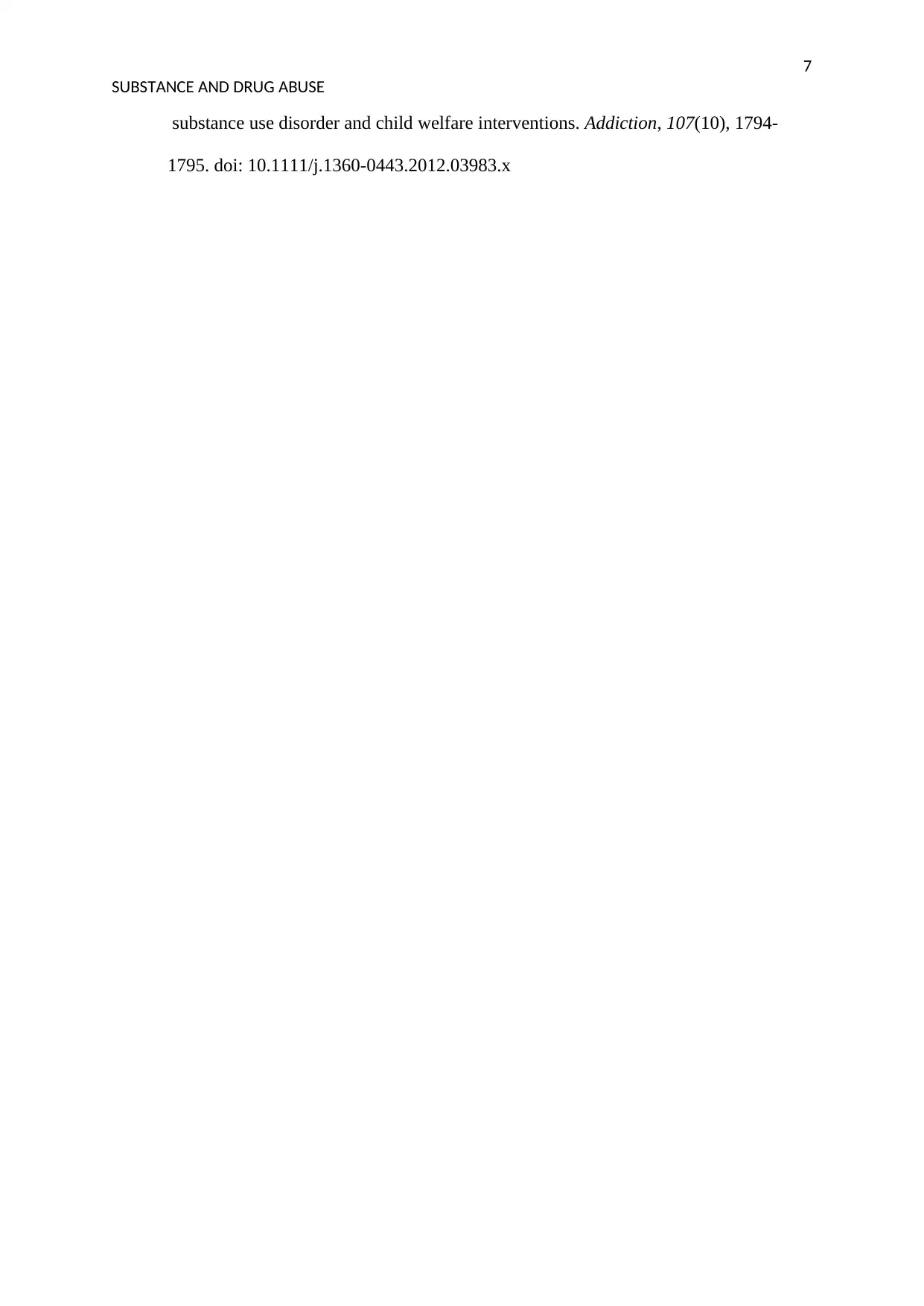
7
SUBSTANCE AND DRUG ABUSE
substance use disorder and child welfare interventions. Addiction, 107(10), 1794-
1795. doi: 10.1111/j.1360-0443.2012.03983.x
SUBSTANCE AND DRUG ABUSE
substance use disorder and child welfare interventions. Addiction, 107(10), 1794-
1795. doi: 10.1111/j.1360-0443.2012.03983.x
1 out of 7
Related Documents
Your All-in-One AI-Powered Toolkit for Academic Success.
+13062052269
info@desklib.com
Available 24*7 on WhatsApp / Email
![[object Object]](/_next/static/media/star-bottom.7253800d.svg)
Unlock your academic potential
Copyright © 2020–2025 A2Z Services. All Rights Reserved. Developed and managed by ZUCOL.





